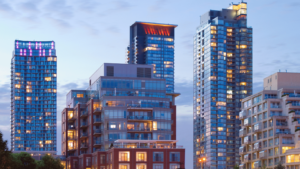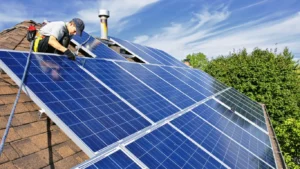Canada is not immune to the risk of earthquakes. The absence of recent seismic activity does not guarantee that future quakes will not occur. The recent earthquakes in Japan prompted a discussion with Keith Porter, PhD, the lead seismic expert at the Institute for Catastrophic Loss Reduction (ICLR.org), to assess Canada’s preparedness and the potential impact on real estate practices.
Dr. Porter states, “The New Year’s Day earthquake in Japan feels comparable to the 1994 Northridge earthquake in terms of the total number of people affected at various levels of shaking intensity. I’m seeing no surprises.” As the death toll continues to rise, there are warnings of potential aftershocks. Porter informed CBC National viewers that this could be a pre-shock, with a larger earthquake possibly on the horizon.
The effects on earth science are in line with what one would anticipate from an earthquake of this magnitude and location, and the performance of buildings, utilities, and transportation infrastructure met expectations. The earthquake occurred on the west side of Japan, an area with fewer seismic events — this is the largest earthquake within 250 kilometres of the epicentre in over a century.
Japan experiences earthquakes relatively frequently — there have been several with a magnitude of 6+ within 100 kilometres in the last 100 years and about 30 within 250 kilometres. This recent one was just relatively large. The damage to buildings was as expected, with the most severe damage occurring to traditional Japanese post-and-beam construction, which is quite heavy and fragile. Dr. Porter notes that Japan has low rates of seismic retrofitting to address these buildings, so it appears that many of the collapses occurred in this type of structure.
Collapses of modern engineered buildings due to liquefaction were observed, as has been the case in past earthquakes. A seven-story building appeared to have experienced liquefaction under the foundation. It toppled over and rotated 90° entirely, as it lacked the type of foundation that would prevent such an occurrence. This is reminiscent of some collapses observed in the 1964 Niigata earthquake when several mid or high-rise apartment buildings suffered liquefaction failure under the foundation, causing them to topple onto their sides.
In the aftermath of Japanese earthquakes, the condition of nuclear power plants is often scrutinized. In this case, there were no damaged plants. The effects of tsunamis are also examined — in this instance, a tsunami of a meter and a half was recorded. It appears that there was limited tsunami protection along the coast, resulting in subsequent damage.
Dr. Porter explains that while there were relatively few fires this time (about five), fire is often a significant secondary risk. While the destruction of homes by fire was devastating for those affected, the number of fires could have been much higher. Landslides were also observed beneath the buildings. Modern construction methods are not capable of preventing this from occurring.
The earthquake that occurred this month was significant, although it did not reach the severity of the 2011 Tohoku earthquake. Nevertheless, it served as a stark reminder of the lessons we have yet to learn and underscored the need for Japan to improve its mitigation strategies for vulnerable buildings. The predictability of these events and the resulting homelessness highlight the urgency of addressing these issues, which have been known for decades.
However, it’s worth noting that North America hasn’t necessarily fared much better. When the inevitable major earthquake strikes California, it’s likely that a significant number of buildings will have undergone retrofitting. California is making strides in addressing its vulnerable buildings.
When considering earthquakes in Japan, one might assume that the Japanese are ahead of the curve in terms of designing resilient buildings compared to Canada and the United States. Unfortunately, this is not the case. Japan’s goal in the event of rare seismic activity is life safety, meaning success is measured by survival and the avoidance of building collapse. However, buildings don’t need to be complete economic losses, leaving many people homeless and businesses displaced.
While the United States, Canada, and New Zealand could all improve, it would ultimately be more cost-effective to construct buildings that are stronger, stiffer, and more resilient to earthquakes. We know what needs to be done and how to do it.
Dr. Porter was asked about the type of foundation that would withstand liquefaction. He explained that it’s either driven piles or drilled piers, referred to as a deep foundation. The seven-story building that collapsed in Japan appears to have been built on what is known as spread footings.
Building with a deep foundation and driving piles into the ground can reduce the potential for liquefaction, as the building is found below the level of liquefiable soil. The additional cost of creating a deep foundation in a seismic zone seems like a worthwhile investment.
Dr. Porter offers the following advice for realtors: “If you’re selling residential, my advice is to get ahead of the disclosures. Find out, before you put the house on the market, whether it has unbraced cripple walls or lacks foundation bolts. Find out in advance with an inspection and solve the problem before you list. I suspect that if it’s marketed well, it would pay for itself and reduce the challenge of dealing with a negotiation when the buyer does a home inspection.”
Whether constructing a new building or modifying an existing one, it makes sense to consider seismic risk. It’s often possible to retrofit a house for greater resilience at a relatively low cost. Dr. Porter also refers to the ICLR homeowner earthquake guide.
Homeowners and their families benefit not only from peace of mind but also if they wait until disclosures and inspections when they eventually sell. They may end up losing more when the buyer backs out. It’s likely that in markets where seismic risk is present, such as California, seismic retrofitting has a real market value.
For clients who own mid-rise apartment buildings, there are ways to mitigate risk. One of the most prevalent vulnerabilities in apartment buildings is tuck-under parking, where the ground floor functions like a basement, with parking situated halfway down and few walls. These structures are prone to collapse during earthquakes. A relatively straightforward retrofit can correct this, although it’s not inexpensive — likely costing around $15,000-$20,000 per unit. Given the severity of the problem in California, some communities are making these retrofits mandatory.
Another risk factor is the aftermath of a fire. When the ground shakes, gas lines and water mains can rupture, and fires can break out, leading to disruptions in road infrastructure. And even if firefighters can reach the fire, water may not always be available. In addition to strengthening buildings and enhancing their resistance to seismic failure, there are also opportunities to store water for firefighting on-site using large cisterns.
It might be beneficial for owners to proactively address these issues rather than risk a major earthquake causing their building to collapse. This could be an investment by a landlord for a multi-unit rental or by a condominium board. This is particularly important for clients whose real estate portfolios lack diversification.
Jessica Shoubridge, the founding executive director of Understanding Risk BC and an expert in natural hazard risk in British Columbia, was consulted for her insights. She says, “This is a financial risk that is not only important to individual British Columbians like me who live in the most gorgeous places in Canada, but it is also considered a financial threat at the national scale.”
She adds, “Seismic risk is so catastrophic and current efforts to address it and fund seismic risk reduction are negligible in comparison. For individuals whose largest asset is their home, the opportunity for seismic risk reduction may be the most important home improvement they make.”





